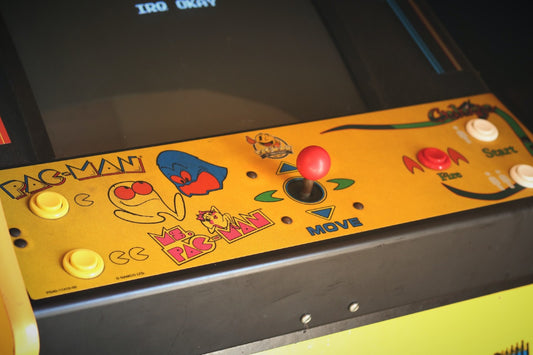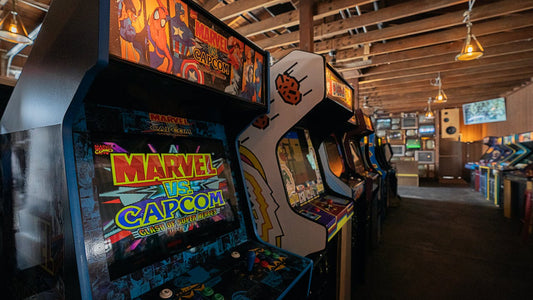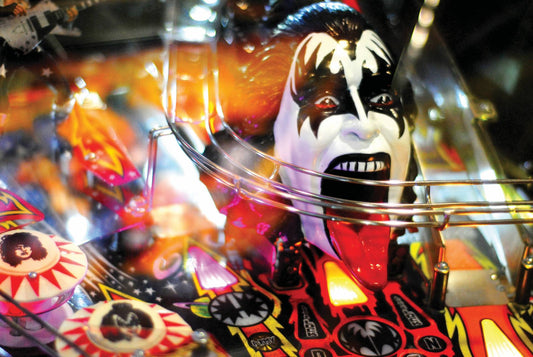Mega Drive
The Sega Mega Drive has been titled one of the best video game consoles of all time. Similarly to our bespoke arcade machines, the 16-bit system features a huge library of over 900 games and instantly became a global success, being the only console to contest against the SNES. It launched franchises such as Sonic the Hedgehog and sold more than 30.75 million consoles worldwide.
Bizarrely, upon Japanese launch, the system did not bide well, only selling 400,000 units within the first year. Sega decided that, to increase sales, something would have to be done. Their attempt at boosting sales of their failing system was to release ground-breaking peripherals and games that would entice the public into buying the console. Some examples of these include an online banking system, answering machine and even a modem!
The company hit more hindrances upon American release. Initially the Sega had an agreement with Atari to release the console under their name, who had an influence in the market and had not yet released a 16-bit console. However, the new founder of Atari (Jack Tramiel) declined this offer as he did not approve of or trust in the video game market. Therefore, Sega were left to fend for themselves and release it through Sega of America. Due to this last minute decision, there was a limited launch of the console just to New York and Los Angeles in its original run.
Nevertheless, across Europe Sega’s previous system (Master System) was a huge success. Building upon this, Sega managed to get the Mega Drive to become the best-selling, most popular home console within Europe. This was also benefitted by Sega’s releases of arcade classics such as Ghouls and Ghosts being launched alongside the console itself.
Over in North America, the SNES had been released and war had waged between the two market-leading consoles. Sega had launched a marketing campaign calling out Nintendo, with catchphrases such as ‘Genesis do what Nintendon’t’. They admittedly struggled, as Nintendo owned the rights to many arcade games causing Sega to step up their game. Challenging this, Sega used celebrity image to market their games, having famous athletes and celebrities star in their own games. An example of this is Michael Jackson’s Moonwalker.
This approach has shown in figures to work, as the console outsold the SNES for four Christmases in a row. It is estimated that this is due to that Sega had a head start in the market, was cheaper and had a larger library of games. At one point in time, Sega had 10 games every 1 SNES game. In 1993, the Mega Drive modelled 250 titles to the SNES’s 75. Moreover, Sega was developing bigger and better games than its rival. An example of this in the SNES’s game Final Fight. Streets of Rage challenged this title, having larger levels and tougher enemies, it is regarded as the better of the games.
Sonic the Hedgehog became one of the most popular and best-selling franchises of all time. The character was designed as part of an internal competition to rival Nintendo’s Mario system. Originally named ‘Mr Needlemouse’, Sonic was rebranded to fit Sega’s image. He became very much a branding tool for Sega, being coloured blue to match the brand colours, had boots based on Michael Jackson’s which were coloured red due to the ‘Bad’ album cover colour contrast, and given Bill Clinton’s ‘Can Do it’ personality.
Sega had built up a brand name of being edgy and marketing towards young adults and adults because of the mature content that they allowed in games. This began to worry American’s as they did not want their children and youth being encouraged by the graphic scenes. A couple of games caused public outcry for something to be done. These games included Night Trap and Mortal Kombat. To defend their title and to still be able to produce such violent and graphic games, the company created the ‘Video Games Rating Council’. This council would personally rate games on the level of how inappropriate content was for children. The ratings included GA (family friendly), MA-13 (more mature content) and finally, MA-17 (adults only). This allowed Sega to release a graphic Mortal Kombat game, which was received well amongst the gamin community, and outsold the family friendly SNES version. Additionally, this council developed into the Entertainment Software Rating Board which was a universal rating system for games.
Upon the launch of 32-bit systems, Sega had expected the Mega Drive to fade out in popularity and be replaced with their new model the Sega Saturn. However, this was not the case as 16-bit consoles were still dominating the market. To increase the life of the Mega Drive even further, add-ons such as the 32X and the Sega CD were produced.
Controllers for the system included a standard controller that had 3 buttons and a direction pad. However, in 1993, a 6 button version of the controller was released. Alongside this, a wireless 6-button version was manufactured named the Remote Arcade Pad.
Peripherals for the system include a converter that allows the Mega Drive to play Master System games, and when the Mega Drive II was brought out a subsequent converter was also made for this. Other peripherals included a light gun called the Menacer.
Another of the less popular peripherals include the Sega Activator, which was an octagonal device that lays flat on the floor and translates the players physical movements into the game. Although revolutionary in its field, the product was infamous for being inaccurate and being sold for a very high price, leading it to become a commercial failure.
Sega also provided network services for their customers. The Sega Meganet was a cartridge and peripheral set that allowed players to play Mega Drive games online. To add to this, they then created the Sega Channel in which the player could download games and presented itself as an early version of the PlayStation Network. Players could download from 50 titles per month which included demos and previews of upcoming games as well. The membership for this peaked at 250,000 players.
As mentioned earlier, the Sega CD expanded the potential for the Mega Drive. Greatly expanding the potential for the size and range of games available for the system. The CD also upgraded the graphics and provided a larger storage of system memory. Furthermore, this allowed games to save high-scores, progress and configuration data. The Sega CD sold over 2.24 million units worldwide.
The Sega 32X was a cheaper alternative of owning a 32-bit Sega system, as it upgraded the previously 16-bit graphics and sold cheaper than the Sega Saturn.
Overall, the Sega Mega Drive is considered by many as one of the greatest systems of all time. It introduced new heights to gaming and even challenged the dominance of Nintendo. Furthermore, creating huge franchises in games and characters such as Sonic the Hedgehog and becoming a huge influence in the gaming world.



